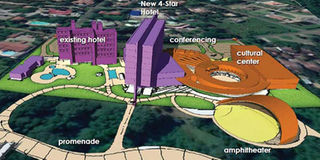Breaking News: KDF chopper crash kills five in West Pokot
Drive to modernise Kisumu waterfront picks up steam

An artistic impression of the Kisumu waterfront project. The project will offer attractive real estate opportunities to spur the region's growth. PHOTO | COURTESY
What you need to know:
- The county government is upbeat that the project will turn around the face of the city and improve its potential as a tourism attraction.
- The five-year Kenya Urban Support Programme is being implemented in 43 counties targeting to address some of the gaps experienced in urban development.
A flurry of activity has been witnessed at Kisumu port as the campaign to restore the once vibrant marine transport system, which connects East African countries, and position the city strategically in the marine economy of the region picks up steam.
Dubbed "Revitalising Kisumu’s Waterfront", the transformation plan entails construction of a world class amphitheatre, setting up an 18-hole golf course, a cultural centre and facelift of three major streets in the central business district.
A paved footpath will connect the amphitheatre to the lake. The place will also house a conference facility, cultural centre, and four-star hotel.
Although the plan is still at the conception stage, the county government is upbeat that the project will turn around the face of the city and improve its potential as a tourism attraction.
The project will also offer attractive real estate opportunities to spur the region's growth. “This will be the key to urban renewal and show the epitome of development, making Kisumu attractive to commercial, conference and cultural tourism,” said Governor Anyang’ Nyong’o.
DEMOLITIONS
Kisumu County Lands and Urban Planning Chief Officer Steve Gome said the campaign will capture development around the port, the golf course and any other development along the lake.
“We are set to build a 10,000-capacity convention centre to change the waterfront. The plan is to make Kisumu look beautiful,” said Mr Gome.
There are also plans to create links to Jomo Kenyatta Sports Ground. Sunset Hotel, owned by Tourism Finance Corporation and the county government, offers a fantastic opportunity to kick-start the project. The hotel sits on 5.5 acres.
Already, buildings constructed along Lake Victoria, including hotels on the famed Lwang’ni beach, have been demolished to pave way for the expansion of the port as well as other businesses that could boost tourism and marine transport.
“We had planned to build modern eateries and beach fronts where Lwang’ni was, but the area has already been taken by the port. We hope to implement the same at Dunga Beach and Hippo Point,” Mr Gome told the Nation on Thursday.
“Key target industries are residential, hospitality, recreational amenities and retail. We see this development as an opportunity to continue the revitalisation of Kisumu and spark an urban renewal on the waterfront,” he said.
PLANNING
In a previous interview with the Nation, Kisumu City Manager Doris Ombara said that structures in Kisumu’s Industrial Area were sitting on a land that holds great potential, which could be exploited better by demolishing archaic warehouses and business premises and replacing them with huge, modern ventures.
There has been a steady decline in the traffic of goods and people over the lake since the 1970s, as the country and region shifted their transport strategy towards roads, leaving some areas around the lake practically unused.
The unused part of the city has created a barrier between downtown Kisumu and the lake. The first plan of Kisumu was prepared in July 1899.
It included landing sites and wharves along the northern lake shore near the present-day Airport Road.
Demarcation of land for government buildings and retail shops was also included in the plan.
Another plan was prepared in May 1900 with plots allocated to a few European firms and Indian traders who had travelled to Kisumu to build the Uganda Railway, and decided to settle at the expanding terminus.
TRANSPORT
For eased access to the lake front, Kisumu City is bracing for a major facelift after the county received Sh790 million for infrastructure.
The World Bank provided the grant through the national government.
The money will go towards construction of three key projects, according to conditions laid down by the donor.
Apart from a rotary youth innovation centre, fire stations and a fire hydrant, the other project is a non-motorised transport system. The projects are underway mostly in the CBD.
The five-year Kenya Urban Support Programme is being implemented in 43 counties targeting to address some of the gaps experienced in urban development.
The streets to be modernised through the programme include Kenyatta Avenue, Oginga Odinga and Ang’awa streets, through an initiative dubbed CBD Triangle.
The rehabilitation will kick off from Kisumu Boys High School roundabout to the KCB roundabout, then stretch to Obote Road and Ang’awa Street, which links Oginga Odinga Street and Jomo Kenyatta Avenue.
Other works to be done include replacement of broken slabs, construction of pedestrian walks and installation of road furniture and toilets.
The CBD Triangle project will be exclusive for pedestrians, hence no vehicles will be allowed through.





